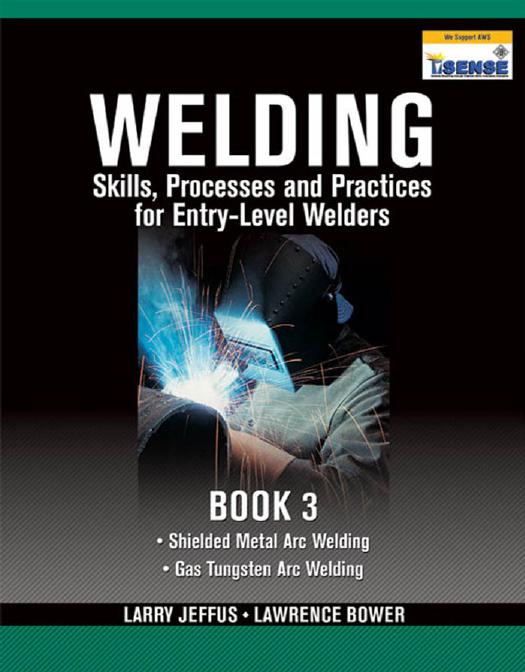Welding Skills Processes -03 by Welding

Author:Welding
Language: eng
Format: epub, pdf
Advanced Shielded Metal Arc Welding
103
As in Practice 3-10, tack weld the plates together with a root opening of 1/8 in. (3 mm) at one end and 1/2 in. (13 mm) at the other end. Using the E6010 or E6011 electrode, start welding the root pass at the wide end. Both sides of the joint must be built up until it is possible to get the metal to flow together. The “J” or “U” weave pattern works best to control the bead.
When the root pass is completed, make a hot pass to clean out any trapped slag before making the filler passes with the E7018 electrode. After the weld is completed, cool, chip, and inspect it for uniformity and defects.
Repeat these welds until you can consistently make welds free of defects.
Turn off the welding machine and clean up your work area when you are finished welding.
Complete a copy of the “Student Welding Report” listed in Appendix I or provided by your instructor.
SUMMARY
Grooved welds on approximately 1/2-in. (13-mm)-thick plate are the most common test plates given to new welding applicants. Groove welds are used by many companies as the base welding skills performance test requirement for employment. The vertical and overhead positions are the most commonly used for the test. It is often assumed in the welding industry that a uniform, visually defect-free weld will successfully pass destructive testing. This assumption has great basis in fact because, in most cases, such a weld reflects the welder’s skills required to produce quality welds, so, in many cases, applicant test welds are evaluated only by the weld shop foreman or supervisor for visual defects. For this reason, you should always attempt to make your welds as uniform in appearance as possible. Learning how to make a “pretty” groove weld can often mean the difference between successfully earning the job and losing out to another applicant.
REVIEW
1. Why are some weld joints grooved?
2. Sketch four of the standard grooves used for welded joints.
3. Why are some backing strips removed from the finished weld?
4. Why are backing tapes used on some joints?
5. Why is it very important to make a weld with a good root surface?
6. What are the two common methods of making a root pass on an open root joint?
7. How can small gaps between the weld plate and backing strip be closed?
8. What effect does changing from a trailing angle to a leading angle have on a weld?
9. What benefit would there be to the root pass if the electrode holder were rocked back and forth while keeping the electrode tip in the joint?
10. What might cause the bright color on the flux as a weld cools?
104 CHAPTER
3
11. What can happen if the molten weld pool becomes too large on a root weld?
12. What can be done to increase the amount of high-strength welding electrode in the final weld if the root weld was made with a low-alloy electrode?
13. What is the purpose of the hot pass?
14. Why should a filler weld pass not have deep penetration?
15.
Download
This site does not store any files on its server. We only index and link to content provided by other sites. Please contact the content providers to delete copyright contents if any and email us, we'll remove relevant links or contents immediately.
| Drafting & Mechanical Drawing | Fluid Dynamics |
| Fracture Mechanics | Hydraulics |
| Machinery | Robotics & Automation |
| Tribology | Welding |
Whiskies Galore by Ian Buxton(40327)
Introduction to Aircraft Design (Cambridge Aerospace Series) by John P. Fielding(32337)
Small Unmanned Fixed-wing Aircraft Design by Andrew J. Keane Andras Sobester James P. Scanlan & András Sóbester & James P. Scanlan(32141)
Craft Beer for the Homebrewer by Michael Agnew(17445)
Turbulence by E. J. Noyes(7037)
The Complete Stick Figure Physics Tutorials by Allen Sarah(6637)
Kaplan MCAT General Chemistry Review by Kaplan(6053)
The Thirst by Nesbo Jo(5783)
Bad Blood by John Carreyrou(5767)
Learning SQL by Alan Beaulieu(5408)
Weapons of Math Destruction by Cathy O'Neil(5034)
Man-made Catastrophes and Risk Information Concealment by Dmitry Chernov & Didier Sornette(4734)
iGen by Jean M. Twenge(4702)
Digital Minimalism by Cal Newport;(4534)
Life 3.0: Being Human in the Age of Artificial Intelligence by Tegmark Max(4502)
Audition by Ryu Murakami(4097)
1,001 ASVAB Practice Questions For Dummies by Powers Rod(4038)
Electronic Devices & Circuits by Jacob Millman & Christos C. Halkias(4024)
Pale Blue Dot by Carl Sagan(4001)
